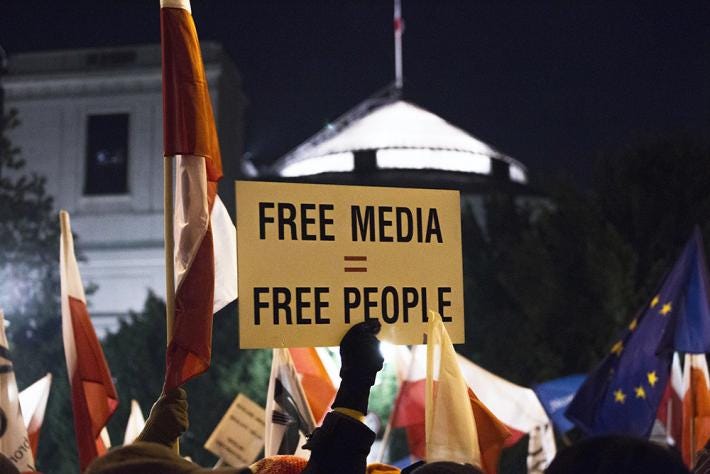The Waymo On Fire
On witnessing destruction, processing overwhelm, and finding my way back to meaningful action
A quick note: I didn’t sleep much last night after writing this post because I knew that “getting political” in my newsletter would turn some people off. After all, this is supposed to be a place for fun and flow, not current events. Right?
Turns out, that’s part of the problem. The pressure to keep things light while they actually feel heavy is exactly what I talk about here, and I believe there’s something to gain for readers on all points along the political spectrum. Sometimes the most caring thing we can do is acknowledge that none of us are okay right now—and figure out how to move forward anyway.
Thank you so much for reading.
A couple nights ago, the state of the world got to me.
It was Sunday, and the weekend had been fine enough—lovely, even. Jake and I started some early-summer purging, cleaned up the yard and prepared for a room addition project we’ve had on the books for years. Aside from that, I wrote up a grocery shopping list, did the laundry, and attended a 50th-reunion barbecue for employees of the local independent music store, Boo Boo Records, where I worked after college.
Like I said, a nice weekend.
That is, until I saw the Waymo on fire.
Up in smoke
As I was getting ready for bed Sunday night, I checked my phone out of habit before setting it on the charger. As I did, a photo came up in my news feed.
The caption explained that several autonomous vehicles were set on fire in Los Angeles as part of protests against President Trump’s immigration raids—more specifically, to protest his inflammatory deployment of the National Guard to that city, making an already awful situation worse.
Seeing the photo, I felt horror bloom in my chest. My husband Jake programs autonomous robotaxis for Waymo’s biggest competitor, and something about seeing one of those intelligent vehicles on fire made me gasp.
I turned to Jake, who was already in bed reading a book. “I feel like I can’t keep doing this,” I told him, holding up the Waymo image with its dramatic orange plumes. “I can’t keep seeing things like this and going on with normal life like everything’s okay.”
Citizen Cope
Since the dawn of time, we humans have made sense of the dichotomy between our personal lives and collective lives. Think about passing a freeway pileup on the way to the dry cleaners. Within minutes of leaving your driveway, you’re faced with the grave, grief-inducing senselessness of the universe. But what can you do about it? At most, you take note and consider the preciousness of life before returning your attention to errands. You’re shaken, but you move on and your mind metabolizes the event somehow.
The Russian journalist Masha Gessen describes this as a uniquely human “desire to normalize, to habituate, to find our footing in any situation, and to keep on living.” In many ways it’s a gift, Gessen says. We are resilient, and that is good—but sometimes the freeway pileups get so extreme and so frequent that we start “normalizing things we really shouldn’t live with.”
I think I first became aware of how it works when I was a war correspondent. And you know, you go into a country — if you get there at the beginning of a conflict — for the first few days, people are just shocked. They’re literally and figuratively shellshocked. Their entire way of life has vanished and they can’t believe it’s happening. Then, two, three days in, people are cooking on the sidewalk or having classes in bomb shelters, and it’s routine, and it’s as though it’s always been like this.
—M. Gessen, “The Beautiful Danger of Normal Life During An Autocratic Rise,” New York Times, June 9, 2025
Cognitive dissonance
Most inhabitants of the United States are not forced to cook on the sidewalk or attend classes in bomb shelters, but it doesn’t take a war correspondent to see we are a nation in crisis. Every day, we face some new flavor of corruption, ineptitude, fear-mongering, contempt, disaster, lies or outright buffoonery. Stories about kids kept in cages and felony convictions for paying off porn stars used to shock us, but at this point they’re just drops from what gushes out of the fire hose. Who can keep up with it all when there are permission slips to sign and aging parents to care for and Halloween costumes to buy and deadlines to meet?
Because, let’s be clear: that’s what most of us want: to live and let live.
But what happens when an image of an autonomous vehicle on fire 189 miles away breaks through the banality of your day, and you just can’t keep pretending it doesn’t affect you?
Or how do you reconcile the image of bare-chested and shaved deportees behind bars with the fundamental notion that “All men are created equal, that they are endowed by their Creator with certain unalienable rights, that among these are Life, Liberty, and the pursuit of Happiness”?
How do you stomach the sight of a president painted with a crown on his head posted on the official (i.e. tax-payer sponsored) White House Instagram feed where he’s quoted as saying LONG LIVE THE KING when you know your nation was founded specifically in rebuke of a monarchy?
How do you ignore the denigration of the press and the criminalizing of academic freedom when you know that these were also the first signs of autocracies formed in Nazi Germany, Stalin’s Russia, Pinochet’s Chile, and present-day Hungary, Turkey, Venezuela, and China?
How do you make sense of a leader who feels the need to tell people repeatedly how smart he is even as he preens under the flattery of anyone who kowtows to him?
In other words, how can a person hold all of it at once and live anything like an integrated life?
The way out
After seeing the Waymo photo that night and telling Jake I couldn’t go on with what writer Adrienne Matei calls hypernormalization, or “the routines of life…threaded with mind-altering horrors,” I decided to get a little help. Fortunately, I have a wonderful therapist in my corner named Dr. Hannah Joy Roberts, who I’ve been seeing for about six months. Because I occasionally do public things (like writing this newsletter), and because Hannah is super cool, sometimes she helps me out with off-the-clock mental health pointers I can share with others. Anyway, that’s how I pitched it to her the next morning: How can we address the cognitive dissonance of our personal and civic lives when there’s so much at stake?
In return, she sent the following audio message. She also sent an overview in the notes below, but I include the audio here just because I like hearing Hannah’s voice saying it.
Be intentional.
Be intentional about how and when you engage in the news and media, especially social media. Who are your trusted sources? How often do you want to check in with them? What times of day are best for you to engage in such an overwhelming of information? Is it the best way to start your day? Or should you save it for after your morning walk and coffee?Be intentional about how and when you participate in your own small life.
Use grounding strategies. Touch REAL grass. Use your five senses. Get your hands in the dirt and grow something. Make yourself a nourishing meal from scratch. Connect with your loved ones.Do something, but don’t try to do everything.
Identify one or two things you can do this week or month to effect change. Donate, volunteer, protest, write letters, share information. Talk about what you’re doing and how it makes you feel with those close to you.
Reading her suggestions, I’ll admit I felt pretty chagrined. I haven’t been intentional about my social media and news diets lately. I trust my sources but I don’t follow any guidelines for how often I engage with them. And while I don’t look at my phone for an hour after I first wake up, I tend to peek at it right before bed—to my obvious detriment.
Other than the occasional lettuce leaf, I rarely touch anything green. My appreciation for the natural world is not what I’d like it to be, as I know how grounding it is to thumb a smooth stone or sit on a tree trunk and watch the fog roll in. To listen to leaves rustling, or taste a wild blackberry. To inhale the herbal scent of a crushed eucalyptus leaf or kelp washed onto shore.
And for all my fear and fierce rage, I don’t resist in any meaningful way. I don’t meet for protests or communicate with my elected officials or talk about politics in any productive, proactive or change-making sort of way.
No wonder I feel so lost.
Let’s get found, together
Do you feel lost, too? Join me in being thoughtful about how and when we engage with media, how and when we show up for ourselves, and in doing something…without attempting to do everything. For my part, during the next two weeks, I’m going to set a couple new intentions on paper, work with my hands, flirt with at least one cute rock or tree, and attend a protest this Saturday in San Luis Obispo.
My hope is that in doing so, I can start to feel a little less fragmented again. Will you do it, too?
See you on the street,











Thanks for the free therapy share. Hannah is the GOAT. If you ever want to be a guest writer for a SLOforhome.org newsletter, I am sure they would love it (I help with the newsletter distribution). Hope to see you Saturday - thanks for the heads up!
I’m grateful to read this. Grateful for mental health suggestions. Grateful for folks who refuse to normalize our current America. And grateful to see you on the streets on Saturday.